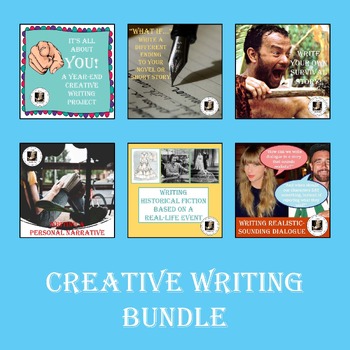Creative Writing Bundle
Products in this Bundle (6)
showing 1-5 of 6 products
Description
These 6 products could provide the creative writing component of your English/language arts program for 2-3 years! They'll provide experience for your students in various specific aspects of creative writing, i.e., essay construction; dialogue techniques; the unique attributes of the historical fiction genre; novels'/short stories' structure; plot development problem-solving; and poetry. These are full or partial descriptions from the six products:
1. It's All About You! - This project, suitable for year-end or as a cumulative poetry study, will give your students an opportunity to be as creative and expressive as they can and want to be! You can set the level of completion for all levels of ability so that all your students can have success; entries can be original compositions, 'found' examples in print and electronic media, or a combination of both. As it says in the guidelines, the results could turn out to be a family keepsake!
2. "What If..." Write a Different Ending to Your Novel or Short Story - To be clear: the 'your' in the title refers to the novel or short story each of your students is reading, not writing, in your class. This product is meant to be an alternative summative exercise for your students, whether they're all reading the same novel/short story or ones they've chosen independently. This product will give them a real critical thinking 'workout' as they assess the main points in the plot and the characters' actions and motivations in order to find a place where they can make a change in the plot that will result in a different climax and resolution. I've provided an excellent version of the 'plot map' diagram for your students' use; two short 'how to' videos; and for you, an (optional) evaluation rubric that includes an example of its use, by describing the plot twist (considered incredibly novel, no pun intended, back in 1985!) that resulted in a surprising and very satisfying ending to the original Back to the Future movie.
3. Write Your Own Survival Story! - Put your students' fertile imaginations to work to write their own survival stories! If 'extreme environments' is a part of your science curriculum, this is a natural tie-in for cross-curricular studies - language arts and social studies. Research about a chosen environment is the key to a successful writing experience, as it will give your students material to work with in terms of setting details and plot development (what do they need to contend with in their environment?).
4. Write a Personal Narrative - Narrative writing is a common-enough task for students, going all the way back to the primary grades, where students cut out pictures from magazines, glue them to paper, and write a story about their picture. As they progress through the grades, however, they're called upon to refine their writing skills; the personal narrative is an example by which students can practice the traditional skills as well as include dialogue and/or an element of reflection. This product gives your students the opportunity to recall a 'small moment' in their past that they can use to do just that. In the higher grades, this could be used as a 'practice' assignment for a college or university application essay.
5. Writing Historical Fiction Based on a Real-Life Event - When students are asked to write a short story in the historical fiction genre, the task may seem overwhelming to some; asking them to write a short story based on a specific historical event will scale down those parameters. When the English teacher and the social studies/history teacher collaborate, the resulting product will be a deeper, richer learning experience for the students.
6. Writing Realistic-Sounding Dialogue - Good writers make writing a story's dialogue look easy and effortless; anyone who's tried their hand at it, though, knows differently. This product provides a number of tips regarding the subtopics of direct vs. indirect dialogue, internal dialogue, dialogue tags, action beats, formatting a conversation and punctuation rules to give your students everything they'll need to record, transcribe and ultimately write out a realistic-sounding conversation.


